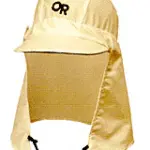Clothing for Hot Weather
The first thing that should be said about outdoor clothing for hot weather is that it should be comfortable. Secondly, a healthy body requires a steady temperature of around 37°C (98.6°F) through the dynamic balance of heat production from muscle work and heat loss from sweating. When this balance is upset and the body can no longer cool or warm itself properly, several heat-related health problems may occur.
How Heat Affects the Human Body



Essential points on outdoor clothing for hot weather:
- Wear desert-type caps with flaps to shade your head, shoulders and neck.
- Wear loose-fitting clothing to allow air to circulate to cool you naturally.
- Wear lightweight, light-coloured clothing for hot weather that reflects heat and sunlight, which will help your body maintain normal temperatures.
- Walk in the cooler times of the day, such as early morning and toward evening, avoiding searing midday temperatures.
- Drink plenty of water or other non-alcohol fluids. Your body needs water to keep cool. Drink plenty of fluids even if you don’t feel thirsty.
Avoid Getting Skin Cancer!
Sunblock with an SPF of at least 15 is commonly recommended for protecting the skin from the sun’s harmful rays; unfortunately, it also blocks the skin’s pores, restricting perspiration and evaporation. When buying clothes for outdoor activities, look for clothing with SPF ratings of at least “SPF 15”. Modern outdoor clothing for hot weather rated “SPF 30” and “SPF 40” is commonly available. In contrast, an ordinary cotton t-shirt offers an SPF rating of only “SPF 5” to “SPF 9”. When damp, much less than that. Well below the minimum “SPF 15” recommended by doctors for even minimal exposure.
If you do not take care of hot conditions and pay attention to your outdoor clothing for hot weather, you are simply begging for trouble. Initially, exertion in heat and lack of water (or loss of water and salt from heavy sweating) will cause cramps. Heat exhaustion comes. Next, your body temperature is still normal, but your skin is cold and clammy. You become thirsty, uncoordinated and feel dizzy. Finally, there is heat stroke, and If you’ve let things get to this stage, you’re in serious trouble. I have been involved in search and rescue operations in Australia’s outback. It is sad to witness occasions where people died due to avoidable heatstroke.

